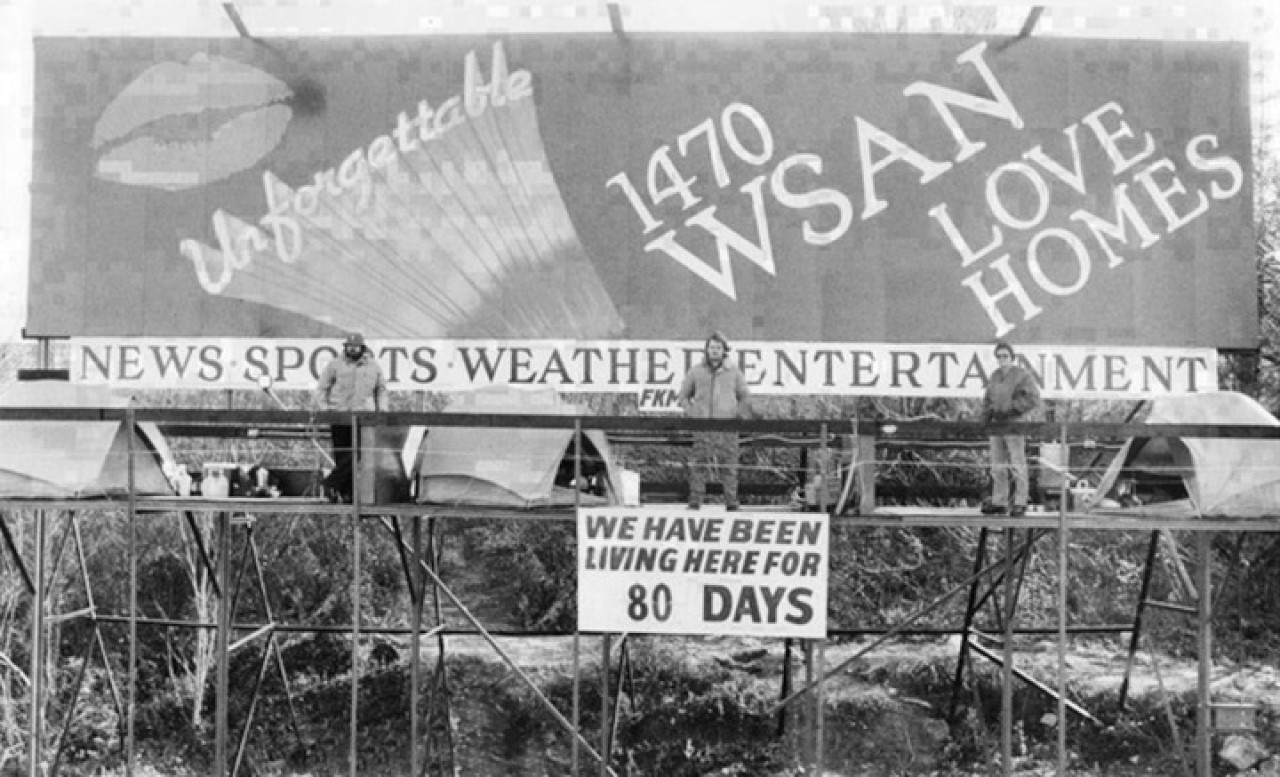
A photo from December 1982 shows contestants in a billboard-sitting contest that eventually dragged on for 261 days.

A photo from December 1982 shows contestants in a billboard-sitting contest that eventually dragged on for 261 days.

A photo from December 1982 shows contestants in a billboard-sitting contest that eventually dragged on for 261 days.
Forty years ago today, a radio contest started in the Lehigh Valley that ended up causing an international media frenzy.
On Sept. 20, 1982, Allentown radio station WSAN-AM was in the middle of rebranding and its staff decided to put on a contest to get publicity.
Called an “endurance contest,” it would pit three contestants to see who could stay the longest on the platform of a WSAN billboard off Route 22 across from the Lehigh Valley Mall in Whitehall Township.
The winner would get a new mobile home.
But the contestants were more serious than expected, and it took 261 days, a drug bust and pleas from public officials to finally drag the competition to a halt.
“We were all taken a little off guard,” said Ned Teter, who was a WSAN radio DJ who worked all throughout the contest.
“You know, this was well before cell phones, social media, any of these things, right? Nothing goes viral in 1982. But somehow this got picked up by a couple of big publications and then you had waves and waves and waves.”
The contestants were:
Mike MacKay, who had a job and was in the first year of a new marriage. According to a 2017 documentary about the contest, “Billboard Boys,” MacKay sent in 47,000 contest entries to WSAN, stamped with the words “I need a home,” saying even with a stable job he couldn’t afford a place to live. MacKay passed away in 2006.
Dalton Young allegedly submitted about 1,000 contest entries after just being discharged from the U.S. Army. He ended up being arrested for marijuana offenses by an undercover police officer while living on the billboard.
Ron Kistler is said to have sent 4,004 entries to the WSAN office. In the documentary, he said he was just in the contest to get a house – not attention.
The contestants were on the billboard platform for the better part of a year with space heaters, tents, toilets, telephones, radios and even a pulley system for friends and family to drop off food and other items to them.
Part of the reason for the contestants’ dedication was because of housing issues in the Lehigh Valley in the early 1980s. Mobile homes were valued at $18,000 dollars (about $55,000 today), but were not affordable, as the region’s manufacturing industry was on the decline.
“These were three guys that, you know, they’re out of work,” Teter said. “These poor souls – they were indicative of the times. We were at ground zero of the Rust Belt – in 1982, work was hard to come by.”
According to one person who knows the story well, today’s affordable housing situation in the Lehigh Valley isn’t entirely different.
Pat Taggart directed the 2017 documentary “Billboard Boys” about the radio contest.
“We have a different housing crisis today, where there’s not enough on the market, and prices are sky high,” Taggart said. “So, different, but at the same time, tremendous economic stress then, tremendous economic stress now, and certainly a big divide between the haves and have-nots.”
Taggart said that throughout the duration of the contest, public opinion in the Lehigh Valley soured toward the men on the billboard.
Roughly half a year in, Young was accused by police of selling marijuana while living on the billboard. Then people in the Lehigh Valley started to become annoyed at the contest.
“Public opinion had really shifted from, ‘Oh, this is interesting and cool,’ to, ‘Oh, this is kind of a stain on the Lehigh Valley,’” Taggart said. “You know, guy’s dealing drugs up there, and there was fender benders constantly” as people driving past stopped to look at the men on the billboard, Taggart said.
Taggart said bystanders also used to hang out and party at the base of the billboard all night long and it was common to find empty beer bottles and other garbage underneath it in the mornings after a weekend.
Another source of pressure: the contestants on the billboard were relentless.
After Young was removed from the contest following his arrest, “You have two guys left – Mike MacKay and Ron Kistler,” Taggart said. “And, they just stayed – and they made it very clear that they weren’t going to get down without a home.”
Taggart described the period toward the end of the contest as a shift for the contestants – from competing against each other to competing against the radio station.
On June 7, 1983, after pressure from the public as well as politicians, WSAN and the contest’s sponsor, Love Homes, caved.
They offered each of the remaining two contestants a mobile home, along with a Chevy car and a free vacation.
MacKay and Kistler both climbed down from the billboard at the same time, and that was the end.
Filmmaker Pat Taggart said he still hopes to turn the story into a feature film.

A collection of interviews, photos, and music videos, featuring local musicians who have stopped by the WITF performance studio to share a little discussion and sound. Produced by WITF’s Joe Ulrich.
The days of journalism’s one-way street of simply producing stories for the public have long been over. Now, it’s time to find better ways to interact with you and ensure we meet your high standards of what a credible media organization should be.